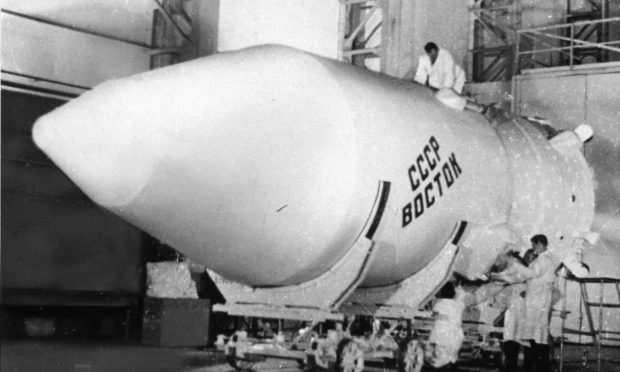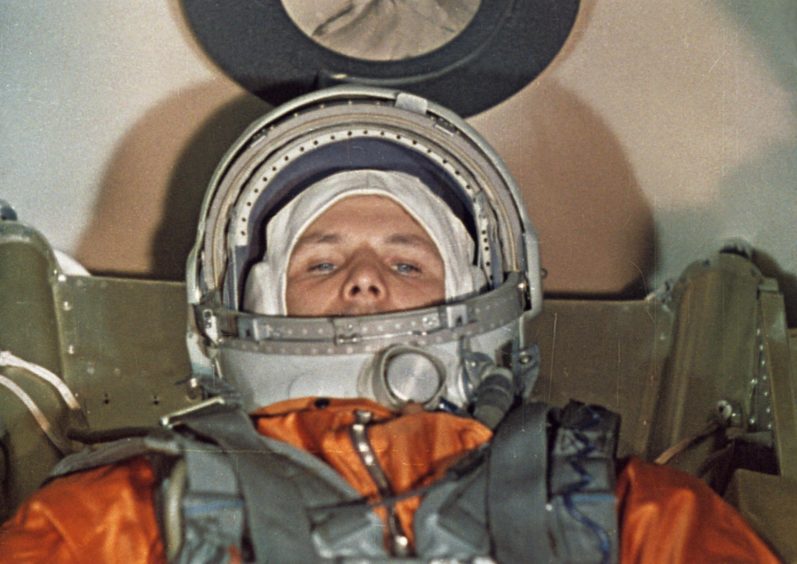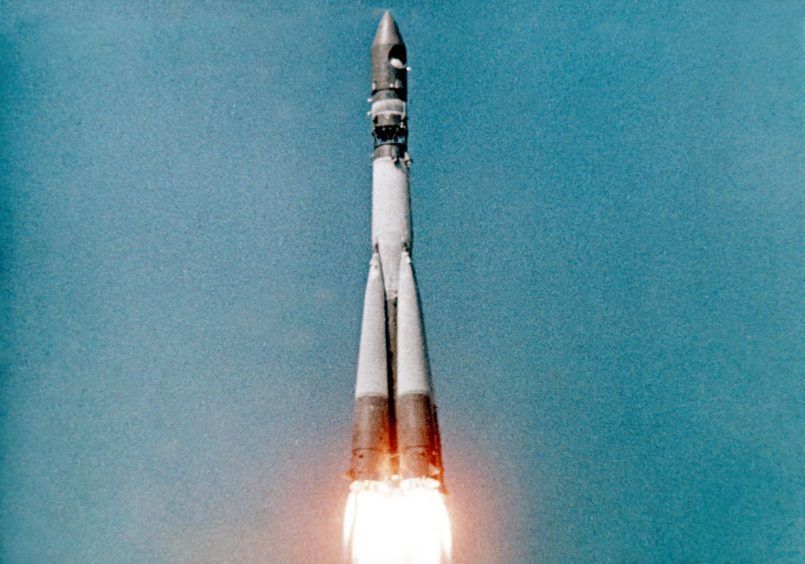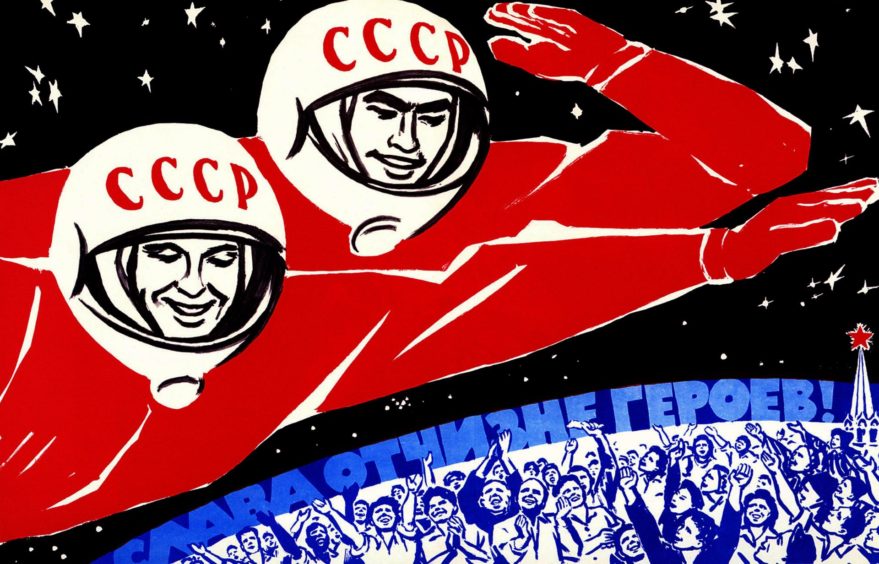He was born into a working-class family; the son of a farmer and carpenter, Alexei, and a dairy maid, Anna, who welcomed visits from his uncle Pavel Ivanovich as the pair gazed up at the sky and talked about the blue yonder.
Even in the mid-1940s, aged 11, Yuri Gagarin was among the many youngsters across the world who dreamt of going boldly into the stratosphere.
And his uncle told him and his elder brother, Valentin, while they chatted about astronomy on chairs made of haybales: “I think there must be life somewhere on the stars. It surely can’t be the case that earth is the only lucky planet among millions….”
Yet, while these conversations were not unusual as Yuri grew up, went to school in the Russian town of Gzhatsk, joined a group called the Young Pioneers, and developed an interest in physics, he became one of the most famous people in the world in April 1961 when he became the first human being to journey into outer space in his Vostok 1 capsule.
It was the culmination of a battle between superpowers, with the USA and the USSR determined to triumph in a climate of Cold War rhetoric and a frenzy of scientific breakthroughs.
But although the Americans eventually won the race to land on the Moon in 1969, there was a very different outcome when Gagarin journeyed where nobody had ever gone before.
The early life of a global trailblazer
There was nothing exotic about the fashion in which Gagarin rose to prominence in the field of aviation. He was fascinated by aircraft from an early age and fashioned paper planes which he despatched into the sky, but, in the aftermath of the Second World War, he rolled up his sleeves and worked hard wherever his muscle was required.
In 1950, aged 16, he began an apprenticeship as a foundryman at a steel plant near Moscow and enrolled at a school for seventh-grade evening classes. He studied tractors, volunteered at a local flying club, and quickly learned how to operate a biplane, but there was no single “Eureka” moment when he decided he was going to be a cosmonaut.
Instead, he focused on helping his family by earning extra money as a part-time dock labourer on the Volga river and amassed a wealth of information about transport, machinery and the minutiae of what made things tick.
He wrote in the 1950s: “The time will come when our space pilots will bring back to earth samples of planetary rocks. And then there will be an even more exciting stage when the exciting journeys will begin – to the moon, to Mars and to Venus.”
But very soon, this was no longer science fiction. And, as Gagarin admitted later, he was in exactly the right place at the right time to emblazon his name in history.
A rapid rise in his quest to reach for the sky
Gagarin was increasingly intrigued by the speed with which the space race accelerated. Within three years, between 1957 and 1959, he had advanced from becoming a lieutenant in the Soviet Air Force to being in contention to explore new worlds.
Colleagues marvelled at how he seemed to have ice in his veins and was blessed with the attitude that genius was an infinite capacity for taking pains. There was no surprise when he was promoted to senior lieutenant in November 1959, just three weeks after being interviewed by a medical commission for qualification to the space programme.Gagarin himself had no idea whether he would be capable of meeting their requirements, and he realised that other men, in both the US and the Soviet Union, were pursuing the same ambition.
But, as the venture intensified and satellites and rockets were hurtled into space from both sides of the great divide, he passed an interminable series of stringent tests with flying colours and proved that he could survive and thrive in the most arduous of conditions.
‘Greatest attention of all was paid to the heart’
He recalled later: “There were many doctors and each of them was as strict as a prosecuting counsel. Verdicts were not subject to appeal and candidates for the space pilot’s job were rejected by the medical board in batches, some by therapeutics and neuropathologists, others by surgeons and laryngologists.
“We were measured this way and that, the whole Morse code was tapped out on our bodies and we were spun around in all manner of special machines, but the greatest attention was paid to the heart.
“The doctors uncovered the entire life story of us all and nothing could be hidden – they were using intricate machines that were capable of discovering the tiniest defect.
“Time passed and I began to think I had been forgotten about or, worse, not found suitable. But when I had lost all hope and was in utter despair of ever receiving an answer, I was ordered to attend the medical board again. It was even more exacting the second time around.
“However, the analyses turned out perfect, there had been no changes in my body and, eventually, I was told the most pleasant words I have ever heard.
“These were: ‘The stratosphere is not the limit for you.'”
‘Man is scared of change, but he likes it’
Following the strict vetting process, half-a-dozen men – known as the Vanguard Six – were accorded the title of pilot-cosmonaut in January 1961 and were further pushed to the limits of their endurance through a two-day examination, led by Lieutenant-General Nikolai Kamanin, the overseer of the Vostok programme.
They were tested in a simulator on a full-scale mock-up of the capsule, then given a detailed written examination. And, at the climax, the special commission ranked Gagarin as the best candidate for the inaugural mission.
He and the next two highest-ranked cosmonauts, German Titov and Grigoriy Nelyubov, were sent to Tyuratam for the final preparations. There was less than three months before blast-off.
Destiny beckoned, but Gagarin remained wary. As he said: “Preparations for man’s flight into space were also being made in the United States. The foreign press had long been reporting successful and unsuccessful launchings of American earth satellites and spaceships. In Life magazine, we saw pictures of a chimpanzee which had flown into space in a rocket launched from Cape Canaveral and had safely returned.
“We also learned that three American astronauts had been chosen for the Mercury project [Alan Shepard, John Glenn and Virgil Grissom] and were told they had already been given special training for 22 months.”
The message was clear: time was absolutely of the essence.
The fateful day beckoned on April 12
On April 12 1961, the Vostok spacecraft was launched on its unprecedented journey from Baikonur Cosmodrome and into the annals forever.
Aboard was the steely Gagarin, the first human to travel into space and who uttered the word “Poyekhali!” (“Off we go”), which became a popular expression in the Eastern Bloc as a means of discussing the space race.
The five first-stage engines fired until the initial separation event, when the four side-boosters fell away, leaving the core engine. The core stage then separated while the rocket was in a suborbital trajectory, and the upper stage carried it into orbit.
Once the upper stage had finished firing, it separated from the spacecraft, which orbited for a duration of 108 minutes before landing in Kazakhstan, while its navigator duly became the first person to orbit the Earth.
He was thrilled by the sense of weightlessness which he experienced on the journey. As he recalled: “I felt wonderful when the gravity pull began to disappear. I suddenly found that I could do things much more easily than before. And it seemed as though my hands and legs and my whole body did not belong to me.
“You neither sit nor lie, but you just keep floating in the cabin. All the loose objects likewise float in the air and you watch them as if you are in a dream. The map case, the pencil, the notebook….drops of a liquid that dropped out of a tube took on a spherical shape and floated about freely until they came into contact with the porthole glass and clung to it like dew on a flower.
“The people on earth wanted to know what I could see below me. I could distinctly see mountain ranges, large rivers, big tracts of forests, islands and the coastline of seas.
“The Vostok sped over my country and a deep feeling of filial love swelled in me. I saw clouds and the light shadows they cast on the dear, distant earth. For a fleeting moment, the [fact I was the] son of a farmer awakened in me and the pitch black sky looked like a ploughed field sown with star-like grain.
“The sun, too, is remarkably bright in outer space and you cannot look at it with the naked eye, even if you squint. To subdue its glare, I had to cover the portholes from time to time with special filters, but it was still an unforgettable feeling. Here I was, making the greatest journey of my life, a journey round the earth.”
Back to earth and a hero’s welcome
Vostok’s return to terra firma prompted exultant celebrations across the USSR, and also provided Gagarin with the opportunity to astonish some local residents near the village of Smelovka after his landing in a field.
He recalled: “As I stepped on the soil, I saw a woman and a girl, who were standing beside a spotted calf and gazing at me with curiosity. I started walking towards them and they towards me, but the nearer they got, the smaller their steps became.
“I was still wearing my flaming orange spacesuit and they were probably frightened by it. After all, they had never seen anything like it before.
“The woman was Anna Takhtarova, the wife of a local forester and the girl, Rita, was her granddaughter. Anna asked me: ‘Have you really come from outer space?’ I told them: ‘Yes, I certainly have’. And then, some machine operators who had run up from a field camp, cried out: ‘It’s Yuri Gagarin, it’s Yuri Gagarin’ and we embraced and kissed as though we were all relatives.
“It was the most remarkable day of my life.”
Everybody wanted to see Gagarin after his return
Gagarin’s achievement was a triumph for the Soviet space programme, and he was accorded celebrity status wherever he ventured in the months ahead.
Less than a month after his manned flight, Alan Shepard became the first American to travel into space, but his exploits were eclipsed by his Russian counterpart, who was escorted in a lengthy motorcade through the streets of Moscow to the Kremlin, where he was awarded the title Hero of the Soviet Union by president Nikita Khrushchev.
As the summer advanced, Gagarin visited the United Kingdom in July 1961 and was acclaimed in London and Manchester where he was met by adoring crowds.
While he was in the second city, he refused the offer of an umbrella, despite the heavy rain which was pouring down, and insisted that the roof of the convertible car in which he was riding should remain open, so the cheering crowds could see him.
And, though he never made it to Scotland during a global tour, encompassing Brazil, Canada, Finland, Iceland, Hungary, Czechoslovakia, Bulgaria, Cuba and many other countries – but not the United States which barred him – that didn’t stop the Fife community of Lumphinnans from naming one of their streets Gagarin Way in his honour.
And it was all down to the pocket of communism which blazed a trail through the community.
Lumphinnans, a long, gangly stretch of a town between Cowdenbeath and Lochgelly which once was nicknamed Little Moscow had as its member on Fife County Council one Robert Smith.
And it was he who suggested Yuri Gagarin’s name be immortalised in west Fife forever.
It was the high point for a man whose life ended prematurely in tragic and mysterious circumstances.
Gagarin died in a plane crash aged just 34
Less than seven years after his historic mission, Gagarin died in a plane crash at the age of just 34. The cosmonaut and experienced flight instructor Vladimir Seryogin were flying a routine training exercise on March 27 1968 from Chkalovsky Air Base when they crashed near the town of Kirzhach.
It was an incident, wrapped in secrecy, which was the catalyst for many conspiracy theories and several investigations were conducted separately by the Air Force, official government commissions and the KGB.
According to Starman: The Truth behind the Legend, a biography of Gagarin by Jamie Doran and Piers Bizony, the KGB worked “not just alongside the air force and the official commission, but also against them.”
And there was even the suggestion that Gagarin’s death had been ordered by Soviet leader Leonid Brezhnev, who was supposedly jealous of the pilot’s popularity, which overshadowed him at a series of public events.
However, in 2011, declassified documents revealed that the commission had concluded Gagarin or Seryogin had “manoeuvred sharply either to avoid a weather balloon in terrible weather conditions, or to avoid entry into the upper limit of the first layer of cloud cover.”
Whatever the explanation, it was a sorry conclusion to the life of a man previously described by Khrushchev as “Russia’s Christopher Columbus”.
His death meant that he never witnessed Neil Armstrong taking his “one small step for man, one giant leap for Mankind” in July 1969.
But Armstrong and Buzz Aldrin left a memorial satchel, containing medals commemorating Gagarin and fellow cosmonaut Vladimir Komarov on the Moon’s surface.
It was a fitting legacy to a momentous achievement.



